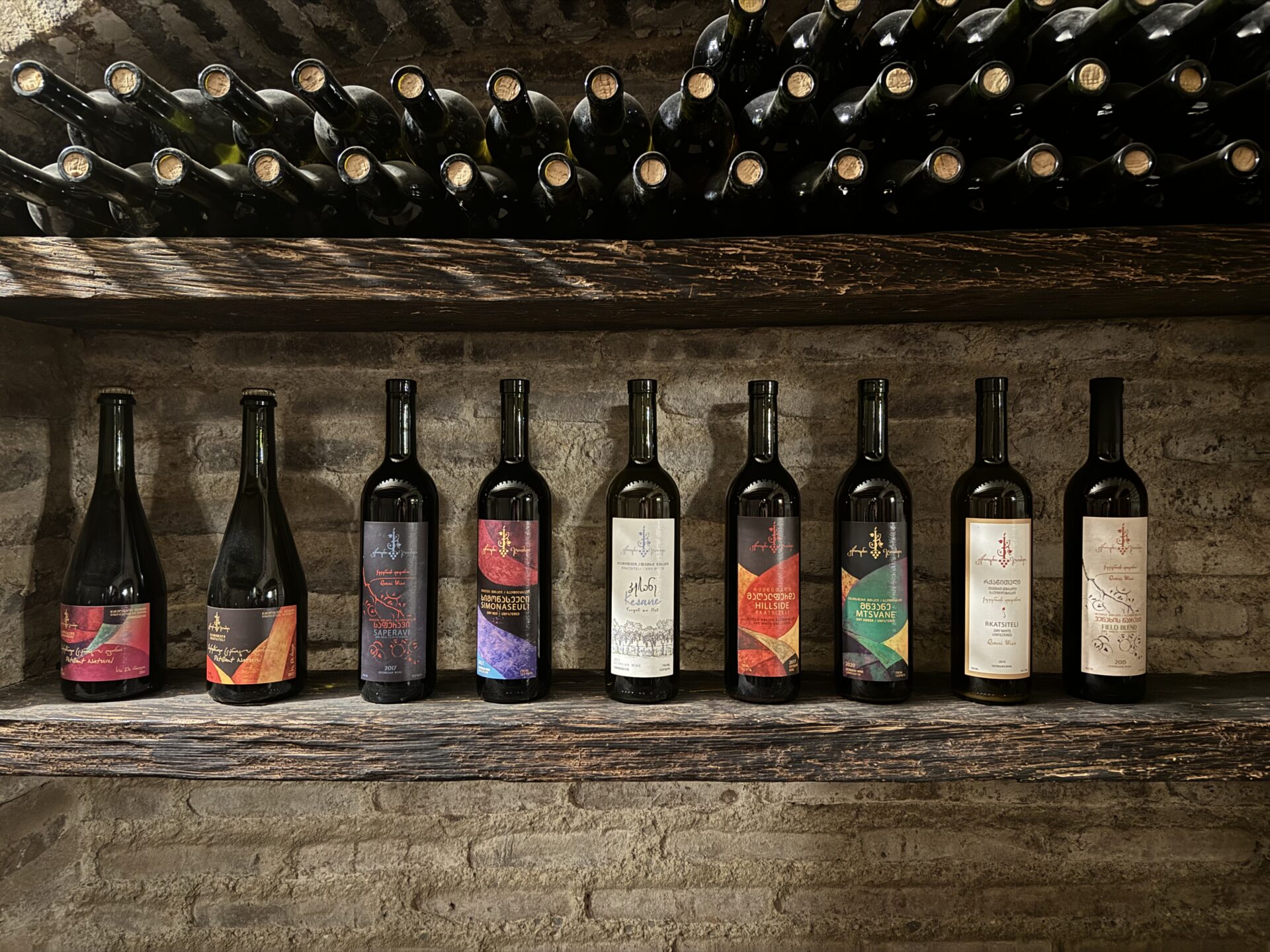This article has partner links that I may receive compensation from at no cost to you. Thank you for supporting my site by using them!
I was most excited to visit Georgia because of the food and the wine. Having previously had Georgian food and wine at restaurants around the world, I couldn’t wait to have them in their homeland. Throughout my time in Georgia, I ate and drank so many amazing things. The highlight occurred on one of my final days in the country when I was invited to join a Kakheti & Signagi wine tour courtesy of Eat This Tours.
How to Book A Kakheti & Signagi Tour + Eat This Tours Coupon Code
Eat This Tours offers premium authentic Georgian food & wine tours. All of their scheduled tours are all-inclusive, small-group tours. They say you won’t end one of their tours thirsty or hungry, and I can confirm that is certainly the case!
The tours of Kakheti & Signagi from Eat This Tours can be booked through their website. I have partnered with them for a special discount code to save you 5% on any tour booking. Just use code: everybody5
Click here to book a Kakheti & Signagi Wine Tour with Eat This Tours
Eat This Tours also offers several other Georgia tours, including private ones. Check out their site for more information.
Book your hotel in Kakheti now!You may spot taxi drivers in Tbilisi with signs advertising cheap tours, including wine tours. I learned that one reason why these drivers can do so for cheaper than professional tour guides is because their cars are LNG-powered. However, the quality is not nearly as good, as the taxi drivers lack the expertise or language skills to provide the best experience. You’re much better off going with experts like Eat This Tours.
Kakheti Wine Tour review
The stops included on each Eat This Tours 1 Day Kakheti Food & Wine Tour from Tbilisi can vary depending on the season and availability, but trust that each included place is one of the best in the region. On my trip, we visited three wineries (Giuaani Winery, Kerovani Winery, and Burjanadze Wine Cellar Winery) and Signagi.
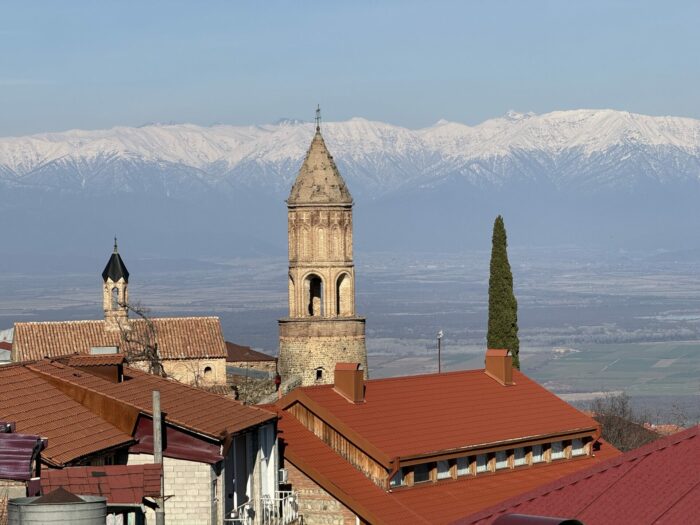
Our morning started with pickups at each of our hotels. I stayed at the Moxy Tbilisi, which I highly recommend as it’s a great value for a quality hotel that’s also conveniently located.
We were promptly picked up by our guide, Levan, AKA Leo, who was driving a nice Mercedes minivan with plenty of space and comfortable seats. He’s been working with Eat This Tours for a couple of years, and as a guide for 11 years, so he was knowledgeable and professional.
Drive from Tbilisi to Kahketi
On the drive from Tbilisi to Kakheti, Leo told us about landmarks, geography, and Georgian history. We talked about the best time of year to visit Georgia, and we also learned more about the history of winemaking in Georgia.
What is the Best Time to Visit Georgia?
According to Leo, the shoulder season is the best time to visit Georgia. In the spring, the land, including the Alazani Valley, is green with many flowers, with the snow-capped Caucasus Mountains in the background. For wine aficionados, May is a popular time for wine festivals in Tbilisi.
Autumn includes the grape harvest season, which starts in August and runs through October, depending on the area, followed by changing leaves. Eat This Tours offers wine-focused trips to suit any season.
I visited in January, and aside from snowy Svaneti, I found the temperature to be quite comfortable in most places, generally as cold as freezing but sometimes a bit warmer. It’s still a good time to visit Georgia, especially if you’re on a budget. Our day trip was the Winter Wine Tour edition of Eat This Tours’ Vines & Villages Signagi Food & Wine Tour.
History of Winemaking in Georgia
We learned more about Georgia’s winemaking history as we headed east from Tbilisi.
Georgia is the oldest winemaking country in the world. Archaeologists have uncovered evidence of winemaking in Georgia that dates back over 8000 years. South of Tbilisi, houses were unearthed with clay jugs & serving elements, as well as a 100-liter clay pot found buried underground. Minerals from the bottom of this pot were dated back to 6000 BC. This clay pot way of winemaking survives to this day through the traditional qvevri method of making Georgian wine.
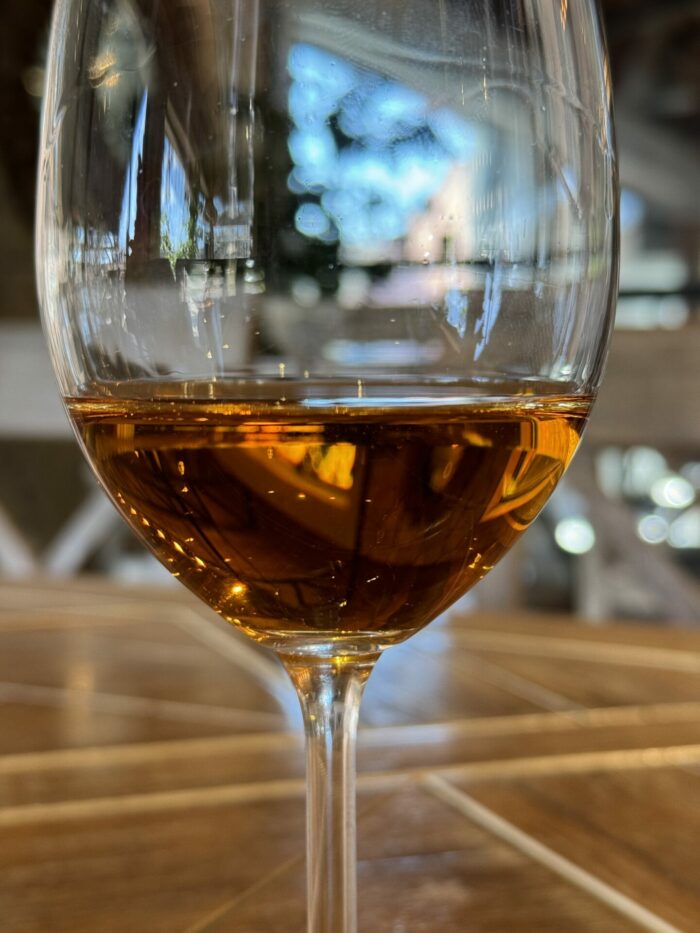
The country is understandably proud of this history, which has been recognized by UNESCO. You won’t encounter anyone in the wine industry who doesn’t mention it to newcomers, and the history is also honored in other ways, such as the name of the Tbilisi wine bars called 8000 Vintages.
As with most of Europe, phylloxera destroyed most Georgian vines in the 19th century. It’s estimated that it killed 80-90% of wild endemic Georgian grape varieties. The Georgian wine industry took further setbacks during the Soviet era, as there was a focus on mass market production instead of quality.
However, Georgia’s wine industry is now experiencing a renaissance. Between the growing recognition as the ancestral home of wine and renewed interest in historic grape varieties and methods of production, the country is beginning to take its rightful place in the world wine scene.
The Georgian National Wine Agency, part of the nation’s agricultural ministry, promotes the growth of indigenous wine varieties. Their vineyards are full of rare grapes from Georgia’s 525 official endemic varieties.
As we discussed Georgian wine, we crossed the plateau that comprises western Kakheti. This part of the region only produces about 10% of Georgian wine; however, the unique geography results in different wine varieties, harvest times, and terroir.
Later, we would see the majestic Alazani Valley, which produces 70% of all wine in Georgia. Throughout the day, we would taste wines from both regions.
Giuaani Winery Tour & Tasting
Our first stop on our Kakheti wine tour was the award-winning Giuaani Winery (website) in Manavi. Our guide, Giorgi, showed us around the well-appointed property and explained the wine production process.
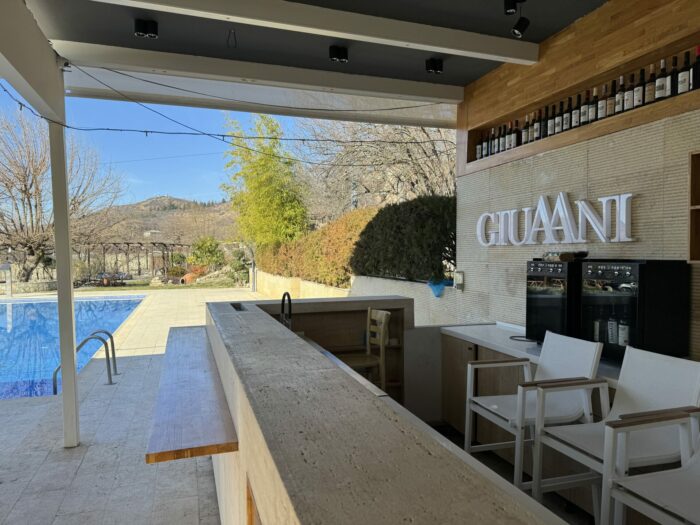
We were in for a special treat after seeing how the wine was made. We had lucked into arriving just as the chief winemaker, Giorgi, was opening a qvevri of Mstvane wine.
A qvevri is a clay pot used in the traditional production of Georgian wine. The wine is fermented and/or aged inside the qvevri, generally for 3-6 months. This same winemaking method has been used for some 8,000 years.
Go to almost any winery in Georgia, and you’ll see the rings marking qvevri on the floor. At other wineries, I had seen both sealed and empty qvevri, but this was my first time seeing the wine inside.
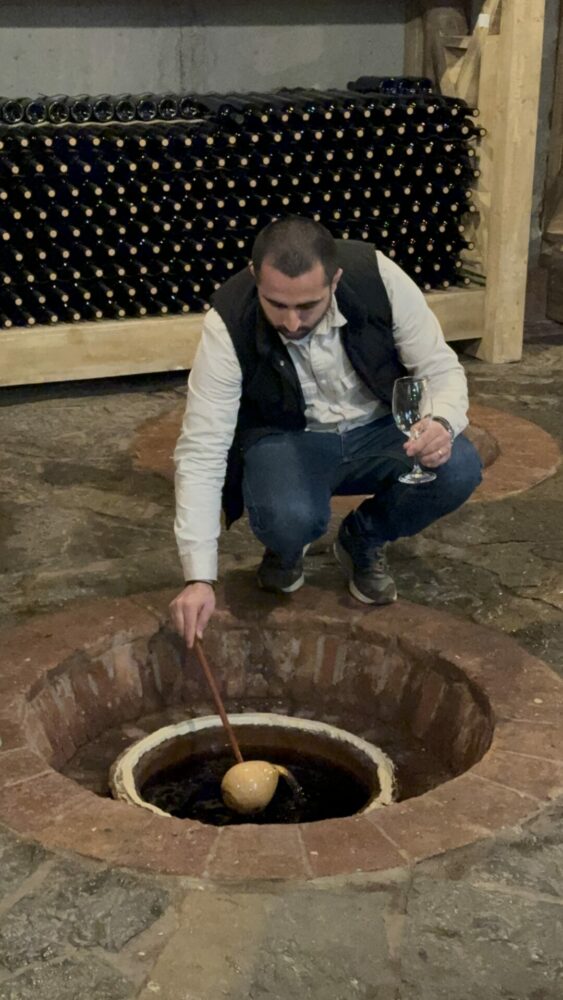
Of course, we also got to taste the wine from the freshly unsealed qvevri. Delicious!
Following this first glass of wine, it was time to head back into the tasting room for our full tasting, which included lunch pairings.
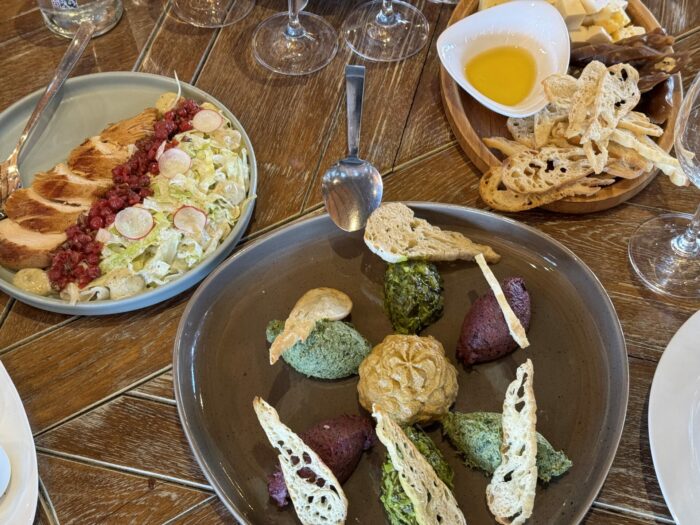
We tried four different wines, each perfectly paired with a Georgian dish. The tasting started with Giuaani Winery’s most important wine, a PDO-designated Manavi wine. It’s made in the European-style (stainless steel tanks rather than qvevri). It was paired with chicken salad and pkhali, which is made from ground vegetables & walnuts.
Next was followed by a lovely 2019 Rkatsiteli Qvevri wine that was amazing with local cheese.
Then we had a 2019 Saperavi Barrel-Aged wine. Saperavi is a signature grape of Georgia, with both skin and pulp that are red, making for a very deep color. This was paired with kubdari, a filled meat pastry dish from Svaneti with spices that amplify the complexity of the wine, and khashlama, another meat dish.

Our final wine was a style I didn’t encounter much in Georgia. The 2023 Tvishi special late-harvest wine is naturally semi-sweet. Paired with buffalo milk yogurt and berries, it was the perfect conclusion to our tasting.
All of the wine pours were generous, plus we were also each able to get second pours of the wines we’d enjoyed the most.
Giorgi, the chef, stopped by to greet us, and we thanked him for the excellent food, while also realizing that seemingly everyone we’d met was named Giorgi, or we’d already had so much to drink that we thought that was everyone’s name. And this was before we’d even had any chacha!
Ah, yes, chacha. Georgia’s everpresent spirit, distilled from grapes, can be found everywhere, from Tbilisi cocktail bars to homemade versions at Georgian supras.
Giuaani Winery produces high-quality chacha that ensures every part of the grape is utilized for something. Our first tasting of chacha was a relatively modest 57% ABV version. However, Giorgi invited those of us who were interested to try a 72% ABV chacha directly from one of their tanks. Who could say no to that?

Bellies full of wine & great food, it was time for us to get back on the road to our next stop.
A Walk Around Signagi
Signagi is a town on the plateau’s edge overlooking the Alazani Valley. Between the town itself and the background of the Kakhetian Mountains of Caucasus, it’s a beautiful place. The combination of the valley & the mountains reminded me of the Central Valley of California.

We stopped for photos in two places before heading to the town itself. At the first, there was a roadside vendor who gave us persimmons. He was also selling chacha (see, I told you, it’s everywhere) and other goods, including small rugs.
Signagi is known as the “City of Love”. It’s a popular wedding destination. In fact, as we stopped at the second overlook, we saw a parade of wedding cars passing by.
Once in the town, we went for a walk, passing by local shops & the city’s gates. The city wall was built, and then people moved inside it. The wall’s 23 towers are each named for the nearby town it defended.
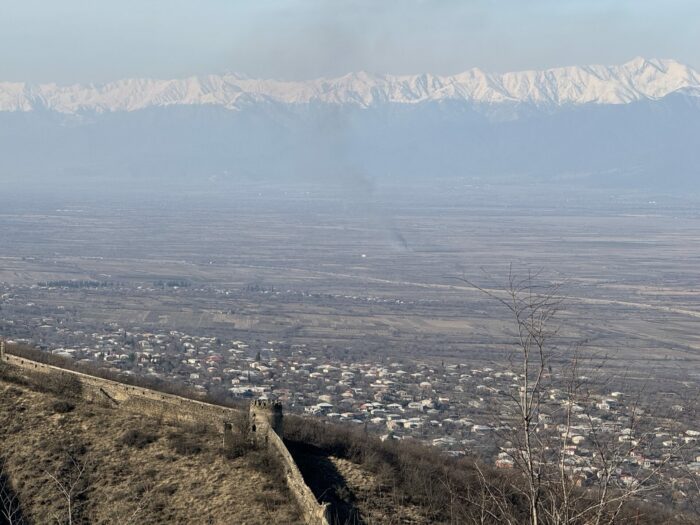
Finally, it was time to head to the next stop on our Signagi wine tour. Along the way, we passed one of the most moving memorials I have ever seen.
The Signagi World War II Memorial commemorates the 300,000 local soldiers sent to the front lines. Only 100,000 returned. The wall is inscribed with a poem memorializing a dead soldier from the afterlife.
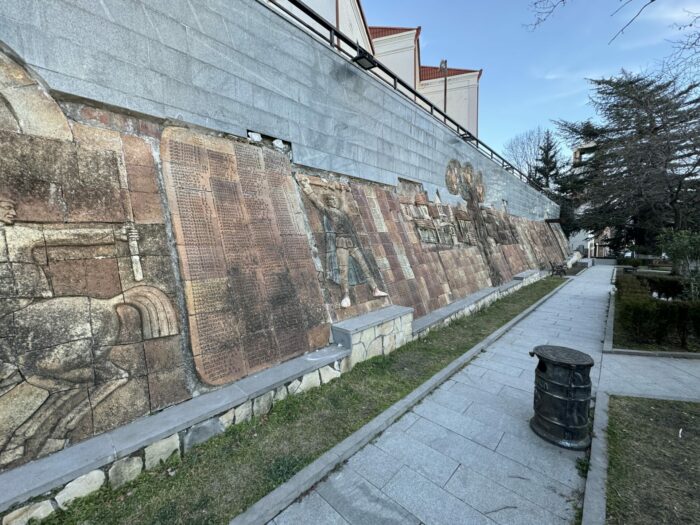
The mural doesn’t just honor the war dead. It also includes other local representations of Kakheti & Signagi.
Kerovani Winery tour & Tasting
Our second winery stop, Kerovani Winery, is located in the neighborhood just south of Signagi’s central square and memorial mural.
We were warmly greeted by the owner, Archil Natsvlishvili, and his cousin, Ilya Bezahshvili. We were also greeted by the cats wandering around the property.
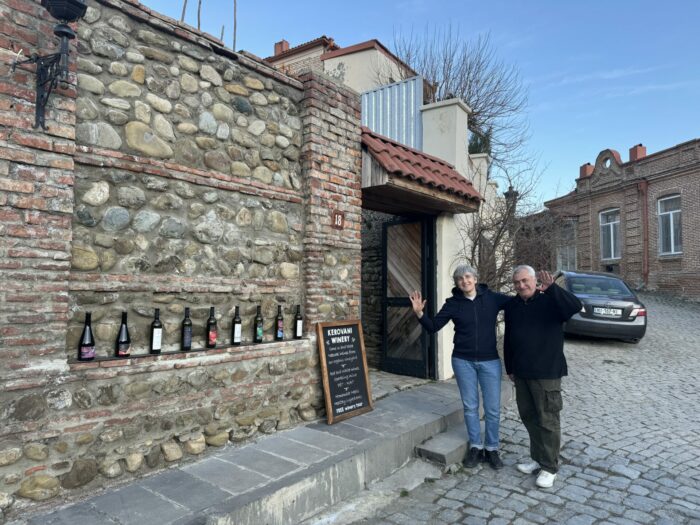
Kerovani Winery (website) specializes in natural wines. They own all of their vineyards to ensure all grapes are grown organically. None of their wines are filtered. Rather than commercializing their wines, they just focus on following traditional methods to create the highest-quality wines possible. Each May, they host a wine festival in Tbilisi called No Compromise.
Our winery tour started by seeing their chacha distillery, which uses the traditional method of distilling. People used to drink chacha in the mornings to start the day with energy. It certainly wakes you up, though I can’t say it keeps you awake. Across from this distilling setup was also a special social event table with a 20-liter qvevri built into it.
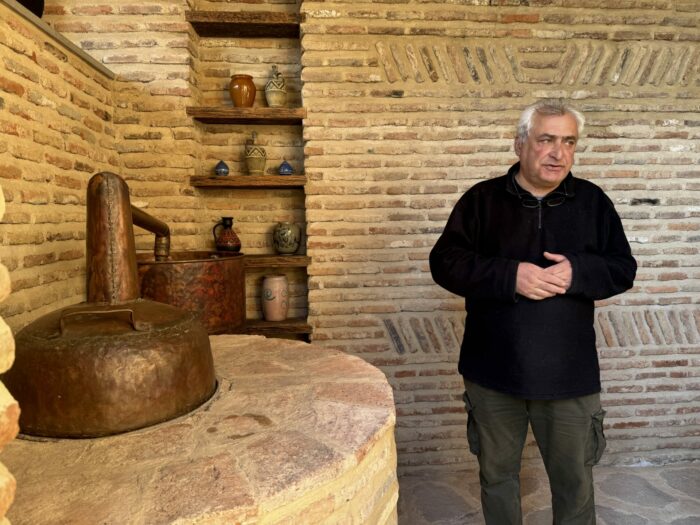
The winery also has a restaurant that cooks homestyle Georgian dishes & is planning on opening a hotel at some point.
Our next part of the wine tour was the marani, where all of the stages of wine production take place. The marani holds a special place in Georgian culture, as it is the wine cellar traditionally found in each home. The marani is home to qvevri, which historically held wine for ritualistic reasons, including religion, family, and charity. This ties to the warm Georgian hospitality that is prevalent to this day.

The marani at Kerovani Winery includes qvevri, each holding 1,500 liters (2,000 bottles). We also saw Pét-nat bottles on racks. This method of creating natural sparkling wine is even older than champagne.
After seeing the production areas, it was time for our wine tasting at Kerovani Winery, which took place in their winter tasting room with a crackling fire.
For our first wine, we tried Kerovani’s Pét-nat, a fascinating wine that starts sweet and then has flavors of apples and pears.
Next was a 2022 wine made from the same Rkatsiteli grapes but made in the European style. It was called Kesane (Forget Me Not).
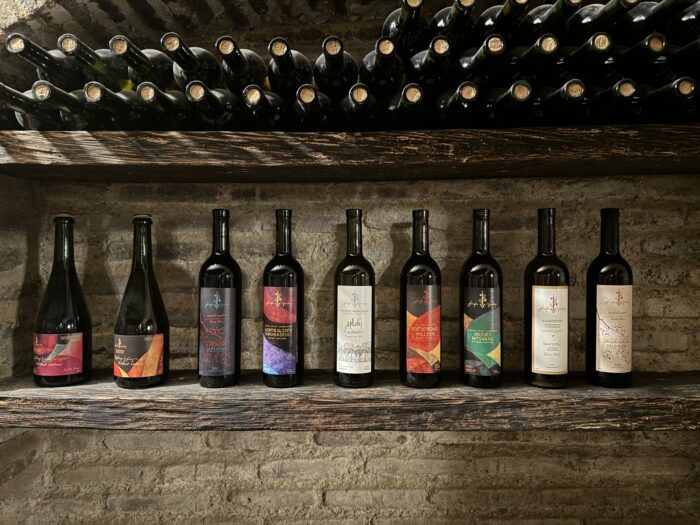
Our third wine was a traditional Georgian amber wine, also made from Rkatsiteli. Note that I have used amber as the description here, not orange. One consistent note across all the wineries I visited in Georgia is that these wines are always called amber, so as to avoid any confusion with people who think the wines are made from oranges. Amber (or orange) wines are skin-contact wines. The color comes from the grape skin pigment, not the clay qvevri in which they are produced in Georgia.
Finally, we had the Simonaseuli 2022, which had a gorgeous color, almost purple. This rare grape spent one month in qvevri before being moved into stainless steel tanks. The wine was dry but packed with flavor.
After yet another great wine tasting in Signagi, it was time to start heading back in the direction of Tbilisi, but not before making one final dinner and wine stop, about an hour away. We drove there as the sun set into a brilliant red, pink, purple, and orange sky, matching many of the wines we had tasted.

A Georgian Supra at Burjanadze Wine Cellar Winery
In case we hadn’t had enough great wine & Georgian food, we had one more stop at Burjanadze Wine Cellar Winery, a family-run natural winery in Sagarejo.
When I say that the place is family-run, I mean it. We were there not just to taste the Burjanadze family’s wine (and chacha) but also for a full Georgian supra. A supra is a feast typically held on special occasions such as holidays, birthdays, St. George’s Day, childbirth, Easter, baptisms, and engagements. Several family members joined us, including the father, mother, grandmother, and Bacho, the son. Bacho served as the tamada (Georgian toastmaster) for the evening, not just leading toasts but also introducing us to everything the family had provided.

I knew we were in for a fun evening when we were served three different drinks (a glass of wine, a glass of mulled wine, and a shot of chacha) before we even entered the house. I especially enjoyed their chacha, which was an oak-barrel-aged version that tasted more like whiskey.
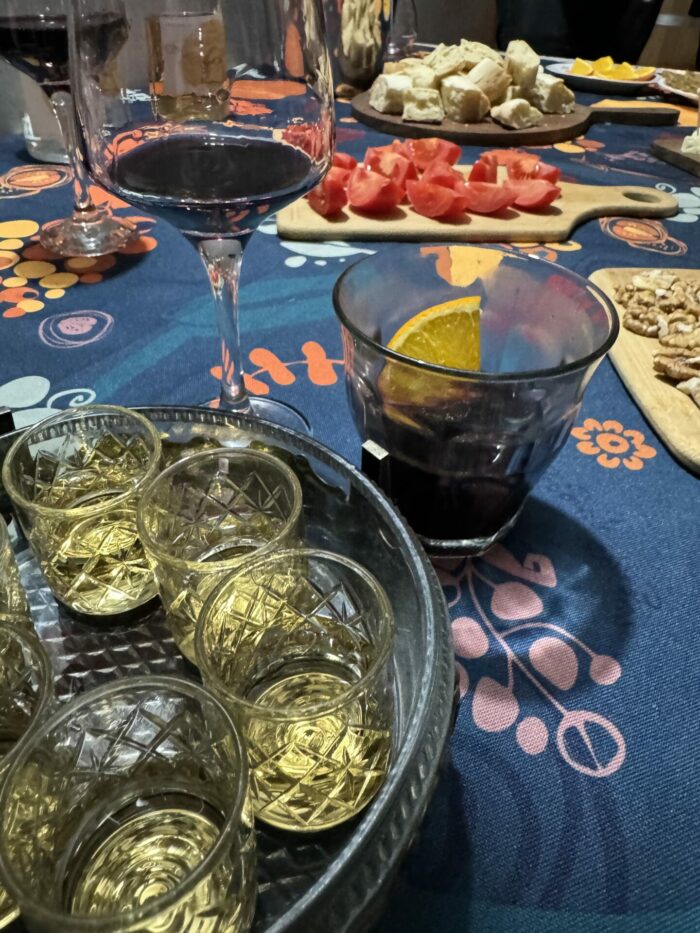
Before heading into the dining room, we received a brief demonstration of how to make a popular Georgian sweet called gozinaki. Gozinaki is made from caramelized walnuts and honey and is typically made during the winter holidays. Like the other Georgian sweet known as churchkhela, it was originally taken away by soldiers as a good energy source.
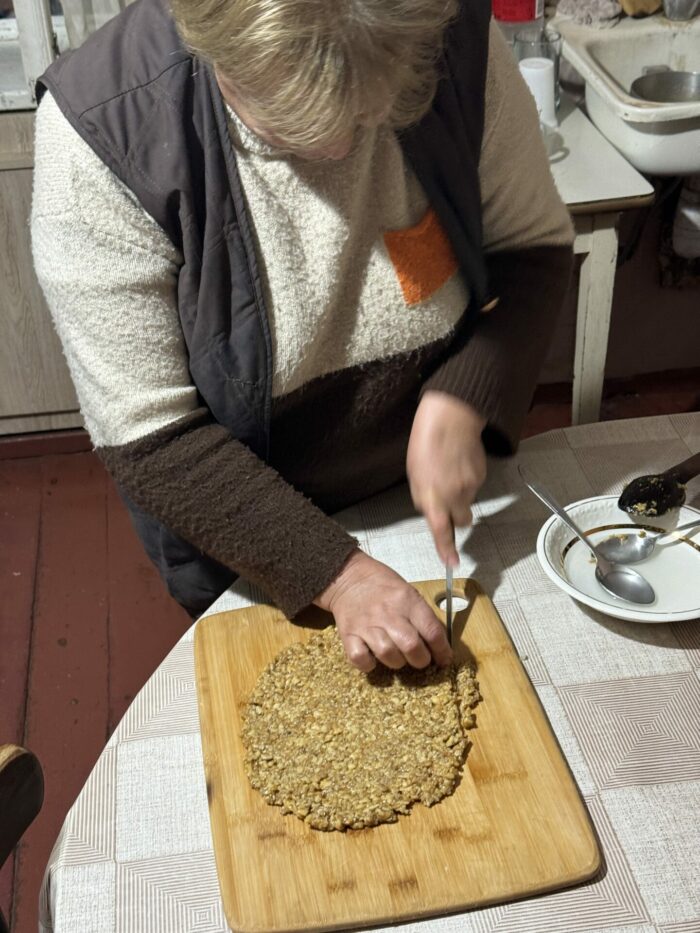
The dining room table was packed with food, but in true Georgian style, there was more to come.
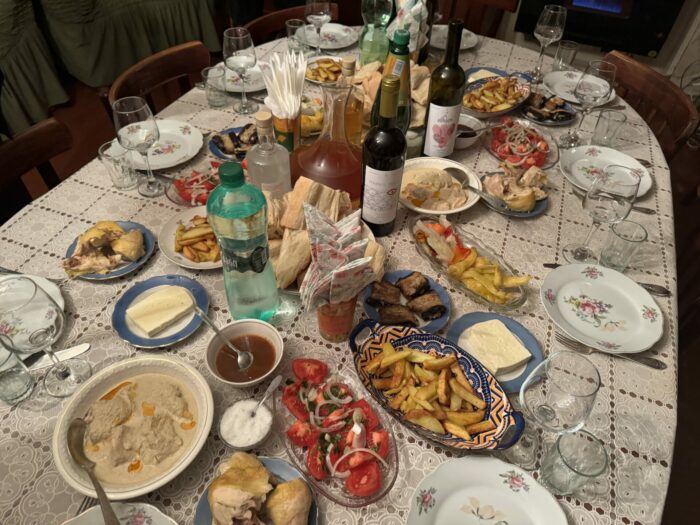
Zaza, the dad, had BBQed pork on skewers over cut grape branches in the front yard. The Georgian plum sauce tkemali (which I’d had in an interesting sour beer in a Tbilisi beer bar) was a perfect pairing.
While there was, of course, plenty of food and drink (including two of the family’s amber wines), what made this experience truly special was the hospitality, community, & entertainment.
The Burjanadze family is a family of musicians. Their late grandfather is well-known in the area. In fact, his name is on the local music school. Subsequent generations have continued this love of music. Bacho played a couple of Georgian musical instruments called the chonguri & the pandjuri.
Then, it was his father’s turn. Zaza headed to the piano to play his own original composition. I expected him to play some classical piece, but then he busted out some rock & roll!
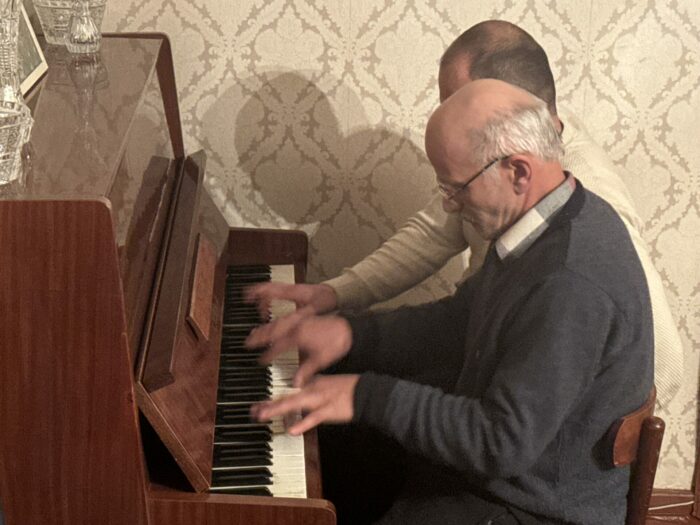
Following a toast, they also sang a folk song about their grandfather and others we have lost. I didn’t know a single word, yet I knew the feeling behind the song.
Bacho, the tamada, did well in his role as toastmaster. A Georgian tamada not only leads toasts but also ensures that everyone is included. We learned that a good tamada leads and inspires but is not a drill sergeant who controls the meal. The value of the experience is made through toasts, sharing, and being together.
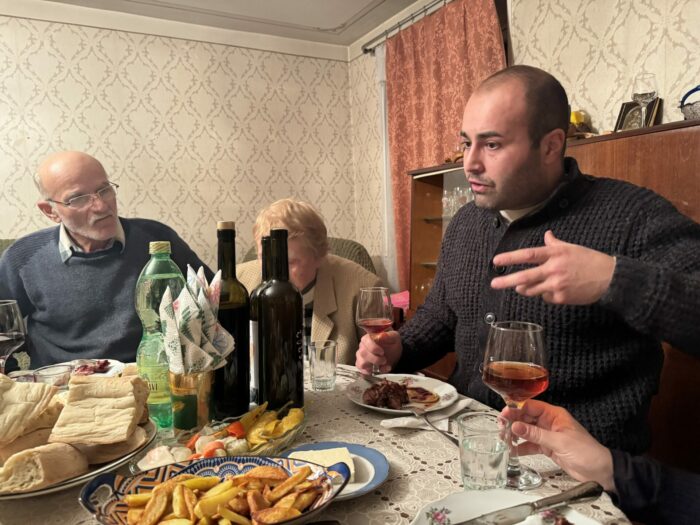
The family has been inviting visitors to their house for about five years. One might think that hosting supras such as these might become routine, but Bacho was clearly passionate about being a leader of the dinner. Each group and experience is unique, so it never gets old, even though the family hosts such dinners every few days or weeks, depending on the season.
Toasts are not just spoken by the tamada. We were also encouraged to make our own. There was no way I could leave Georgia without making a toast to the wonderful country that had hosted me so well over the previous three weeks.
I toasted the hospitality of the Georgian people and the specialness of Georgian culture. I toasted about how it’s vital that the world preserves and honors this uniqueness so we don’t become so homogenized that we lose the things that make each place around the world special. In a world full of Coca-Cola, I want more Georgian pear soda.
Summary
I loved my wine tour of Kakheti with Eat This Tours. We visited several excellent wineries and ate so much great food, especially at the supra, one of the true gems of Georgian culture. It was yet another great example of Georgian hospitality and a wonderful experience to wrap up my trip to Georgia.
While the tour lasted the entire day (from roughly 9 am to 10 pm), it didn’t feel that long at all. In fact, I would have been happy to stay even longer! It’s nice that the wine tour stops are split up, so you never drive for more than an hour or so at a time.
No visit to Georgia is complete without joining in the country’s rich food & drink traditions. This wine tour from Tbilisi is the perfect way to do so.
Click here to book a Kakheti Wine Tour with Eat This Tours Reminder – Use code everybody5 to save 5% on all bookings!
Here are some other great Tbilisi tours & activities.
Need a place to stay? Check out these Tbilisi hotel options. I enjoyed my stay at the Moxy Tbilisi, and the Radisson Blu Iveria Hotel is another excellent option.
Note: I was an invited guest of Eat This Tours for this Georgian food & wine tour; however, all opinions are 100% my own

